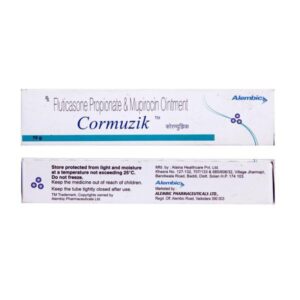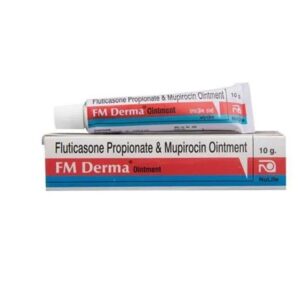MUPIROCIN + FLUTICASONE
Mupirocin: Mupirocin is an antibiotic medication used to treat skin infections caused by certain bacteria, including impetigo and methicillin-resistant Staphylococcus aureus (MRSA). It is available in the form of a topical ointment or cream.
The mechanism of action of mupirocin involves inhibiting bacterial protein synthesis by binding specifically to bacterial isoleucyl-transfer RNA synthetase. This prevents incorporation of isoleucine into bacterial proteins, ultimately leading to disruption of protein synthesis and bacterial cell death.
For the treatment of impetigo, mupirocin is typically applied to the affected area three times a day for a duration of 5 to 7 days. In the case of MRSA infection, it may be used for 10 to 14 days. It is important to follow the dosage instructions provided by the healthcare professional or the instructions on the medication package.
Common side effects of mupirocin include local skin reactions such as burning, itching, stinging, and rash. These side effects are usually mild and resolve on their own. In rare cases, allergic reactions may occur, characterized by severe itching, rash, swelling, and difficulty breathing. If any unusual or severe side effects are experienced, medical attention should be sought immediately.
It is worth noting that mupirocin is for external use only and should not be ingested or used in the eyes, nose, or mouth. It is also essential to avoid extended use or overuse of mupirocin as it may contribute to the development of antibiotic-resistant bacteria.
Fluticasone: Fluticasone is a medication that belongs to the class of drugs called corticosteroids. It is primarily used for its anti-inflammatory properties and is commonly used to treat respiratory conditions such as asthma and allergic rhinitis.
The main mechanism of action of fluticasone is its ability to reduce inflammation. It works by inhibiting the release of inflammatory substances in the body, which helps to decrease the symptoms associated with respiratory conditions. Fluticasone is a synthetic corticosteroid that is similar in structure to the hormone cortisol, which is naturally produced by the adrenal glands.
Fluticasone is available in various formulations, including nasal sprays, inhalers, and topical creams. The specific dose and administration method depend on the condition being treated. For asthma, it is commonly used as an inhaler, and the recommended dose can vary depending on the severity of the condition. For allergic rhinitis, it is usually administered as a nasal spray, and the dose is typically one or two sprays in each nostril once daily.
As with any medication, there are potential side effects associated with fluticasone. Common side effects of fluticasone include nasal irritation or dryness, sore throat, cough, headache, and nosebleeds when used as a nasal spray. When used as an inhaler, side effects can include throat irritation, hoarseness, and fungal infections in the mouth.
Although rare, there is a possibility of systemic side effects when using fluticasone for extended periods or at high doses. These side effects can include adrenal suppression, osteoporosis, cataracts, and impaired wound healing. It should be noted that these systemic side effects are more likely to occur with long-term use or when high doses are used.
It is important to follow the prescribed dose and instructions provided by a healthcare professional when using fluticasone. If any side effects are experienced or worsen, it is crucial to inform a healthcare provider promptly.


